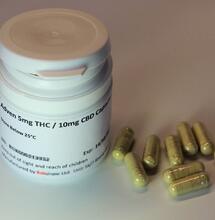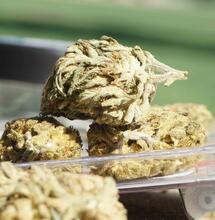Container Culture and Hydroponics

Understanding some basic concepts about container culture and hydroponics is essential to avoid problems and harvest a heavy crop. Often cannabis gardeners get side tracked and spend their time on designing and trying new garden systems that they forget to pay attention to the basics - oxygen and nutrient solution balance.
Understanding some basic concepts about container culture and hydroponics is essential to avoid problems and harvest a heavy crop. Often cannabis gardeners get side tracked and spend their time on designing and trying new garden systems that they forget to pay attention to the basics - oxygen and nutrient solution balance.
Understanding some basic concepts about container culture and hydroponics is essential to avoid problems and harvest a heavy crop. Often cannabis gardeners get side tracked and spend their time on designing and trying new garden systems that they forget to pay attention to the basics – oxygen and nutrient solution balance.
This short article distinguishes “solution “culture” from media culture,” “hydroponics” and “container culture” as well as focuses on oxygen levels in solution and substrates.
| DWC grow tanks are set up and filled with nutrient solution. |
Solution Culture
Cannabis grown in hydroponic solution culture gardens do not use growing medium. However plants in some gardens are started in a small net pot in a handful of substrate. Examples of solution culture include aeroponics, bubbleponics, Deep Water Culture (DWC), Deep Flow Technique (DFT), Nutrient Film Technique (NFT), and Raft solution culture. These gardens require an electric pump that must function 24 hours a day to operate nutrient solution drippers, emitters, air (oxygen) diffusers, misting nozzles and often a good filter to ensure debris-free solution.
Media Culture
| The same clones one week later look a lot stronger and healthier, but they have not completely recovered from the transplanting. |
| Two weeks later, the garden looks like it is growing well and plants have put on growth. |
Media based hydroponics uses an inert substrate such as rockwool or expanded clay pellets. The inert substrate does not react chemically with nutrients. Container culture employs substrate such as soilless mix, coco coir, etc. that is not inert and will react chemically with the nutrient solution. The substrate, whether inert or not serves multiple functions – anchor plants, hold air, water and nutrients for root uptake. The media also holds precious oxygen that is essential for rapid nutrient uptake. Ideal growing mediums hold plenty of air (oxygen) and nutrient solution at the same time. Soilless mix and coconut coir are two of the most popular growing mediums used in container culture. Rockwool and expanded clay are the most common substrates found in hydroponics. Nutrient solution is delivered to the media via flood and drain, top-feed or passive wicking that relies on capillary action.
| The harvest from a small garden is small, but enough to sustain many medical cannabis gardeners until the next crop. |
Medium culture systems can be classified as follows, Ebb and Flow (Flood and Drain), Hydro-Organic, Top-Feed – Containers and Slabs, Run to Waste (RTW), and Wick (passive).
In container culture and many types of hydroponics the supply of oxygen in growing media can be maximized which in turn allows properly grown plants with healthy roots to take in peak levels of nutrients. However, in “solution culture” it is very difficult if not impossible to consistently achieve the same oxygen levels as in a properly aerated growing media. Fine-tuned nutrient solutions can steer plants to grow less leafy vegetative foliage and more dense flower buds.
Properly mixed and applied hydroponic nutrients – chemical salts diluted in water – are able to supply exact element levels so that roots have access to them and the possibility of taking them in at maximum capacity. Aerated nutrient solution is absorbed, wicked up from the growing medium or it passes over roots later draining off. The oxygen in solution, around roots or trapped in the soilless medium speeds nutrient uptake. Organic nutrients – natural elements and compounds – are more difficult to control in container culture than their chemical counterparts. In nature these nutrients are often bound in complex living chemical compounds that are difficult to measure accurately.
Regardless of the nutrient solution application method, nutrient solutions are either run to waste (RTW) and not reused or they are re-circulated and used again and again rather than being discarded after one use. Recirculating systems have the added complication of concentrating the nutrient solution and the accumulation of plant wastes – broken roots, leaves, etc
| Individual containers are irrigated by spahhetti tubes in this perfectly set up medical cannabis garden from Trichome Technologies in California. |
| This run to waste garden uses fabric pots to air prune roots grown in soilless mix. Plants are irrigated by hand daily. |
Nutrients are diluted in water in a “soil solution” or in an inert medium “hydroponic solution.” In soil, soilless mix, coco coir, etc. there is a naturally occurring ratio of oxygen to nutrient solution. However in hydroponics using rockwool, expanded clay pellets or other inert ingredients, this ratio must be “manufactured.” And in any hydroponic garden where roots are covered with nutrient solution all the time, oxygen is contingent upon oxygenating the solution artificially and it is very easy to screw up.
*Lincoln Taiz and Eduardo Zeiger Plant Physiology 3rd Ed, Sinauer Associates, Inc., Sunderland MA, 2002 pg 616-617 say 20 mg/l average.
At maximum levels of stirring, the amount of dissolved oxygen will be barely enough to keep up with O2 utilization, and to get as close to 60 ppm as possible oxygen must be diffused into the solution, typically with an electric air pump.
In the older root zones this lack of oxygen becomes an issue earlier at lower rates since their uptake is reduced to 10% of the tips, the cores can become anoxic (severely deficient in oxygen) or hypoxic (oxygen deficiency causing a very strong drive to correct the deficiency) killing the roots or affecting performance.
The best way to achieve maximum aeration is not growing in deep water that covers roots all the time, but allowing dry time for the roots; because at this time, the solution on the root surface is still dissolving O2 at higher levels when the air moves in and the water is gone. No extra aeration is needed other than stirring the nutrient reservoir. The amounts of oxygen needed by the root system will be absorbed at the root surface as well.



